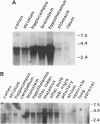Abstract
By using a strategy based on nucleotide sequence homology, we have cloned a cDNA encoding a functional serotonin (5-HT) receptor. The deduced amino acid sequence of the 5-HT7 receptor displays limited homology with that of other 5-HT receptors. In addition to the seven stretches of hydrophobic amino acids that characterize the superfamily of receptors interacting with guanine nucleotide-binding proteins, the 448-aa sequence of the 5-HT7 receptor contains a hydrophobic domain located at its N-terminal end. Genomic analysis indicated the presence of introns interrupting the coding sequence. The 5-HT7 receptor, stably expressed in transfected CHO cells, bound [3H]5-HT with high affinity (Kd = 1 nM), like receptors of the 5-HT1 subfamily from which, however, it was clearly distinguished by its pharmacology. 5-HT in nanomolar concentrations stimulated cAMP accumulation in these CHO cells by approximately 10-fold, whereas lysergic acid diethylamide displayed low intrinsic agonist activity. These various properties differentiate the 5-HT7 receptor from the four other subfamilies of mammalian 5-HT receptors (i.e., the 5-HT1-, 5-HT2-, 5-HT3-, and 5-HT4-like subfamilies) and, therefore, appear to define another receptor subfamily. Northern blot and in situ hybridization analyses showed the 5-HT7 transcripts to be expressed in discrete areas of the limbic brain (e.g., pyramidal hippocampus cells, tenia tecta, amygdaloid, or mammillary nuclei), suggesting that the receptor mediates serotoninergic controls in functions like mood, learning, or neuroendocrine and vegetative behaviors.
Full text
PDF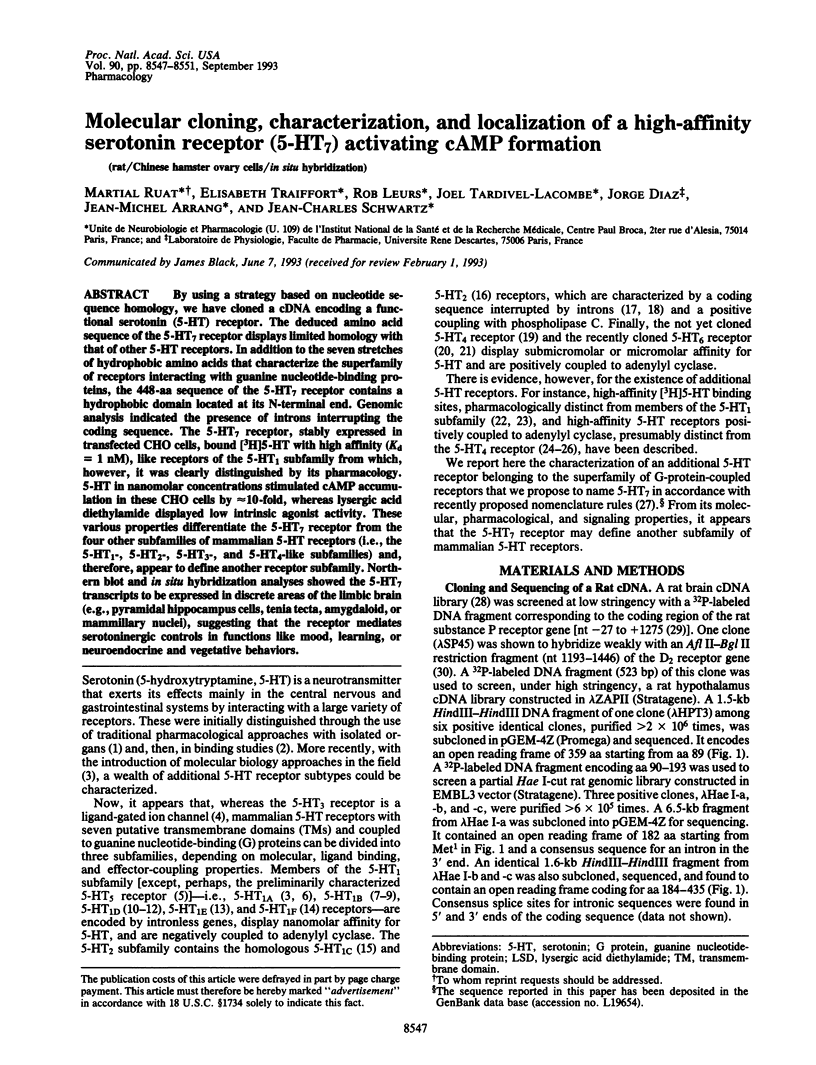
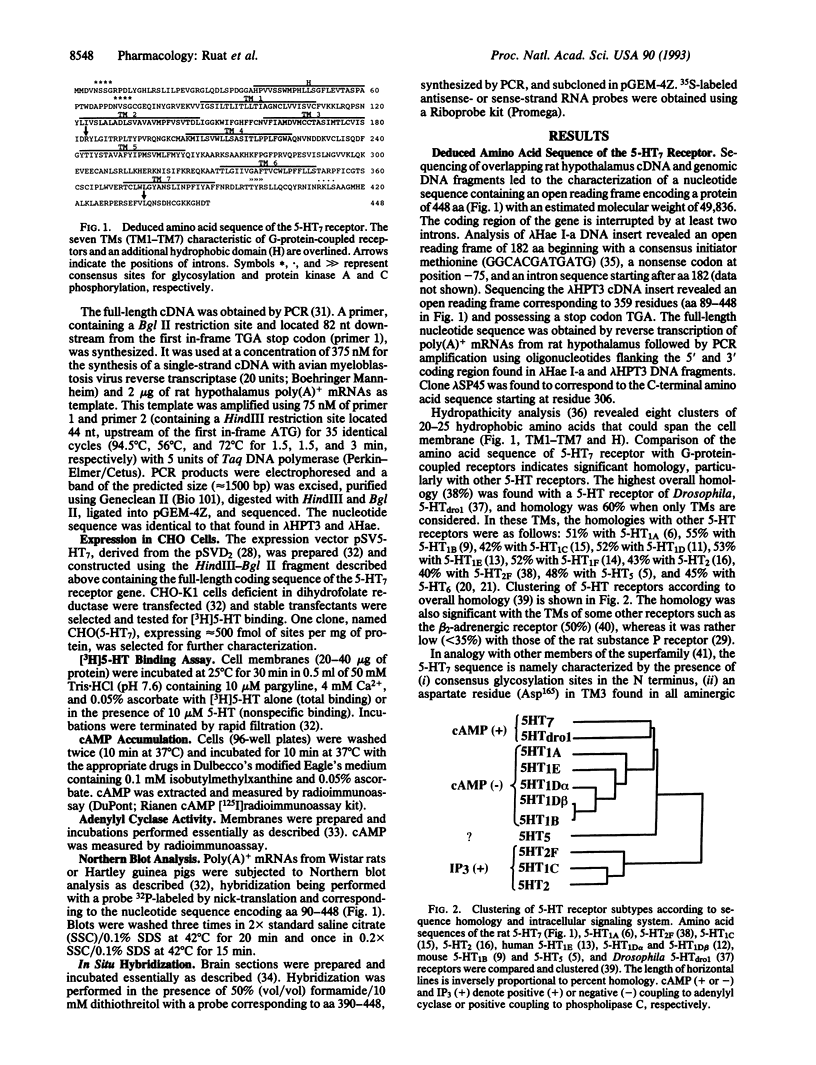
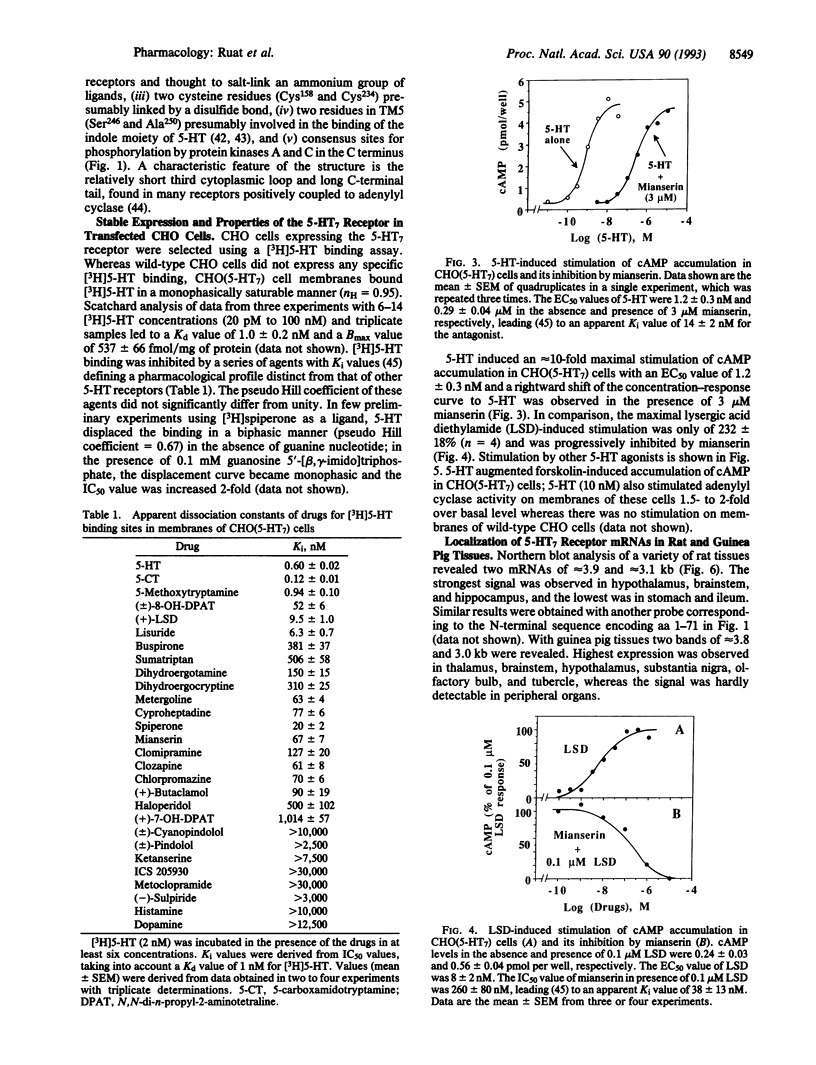
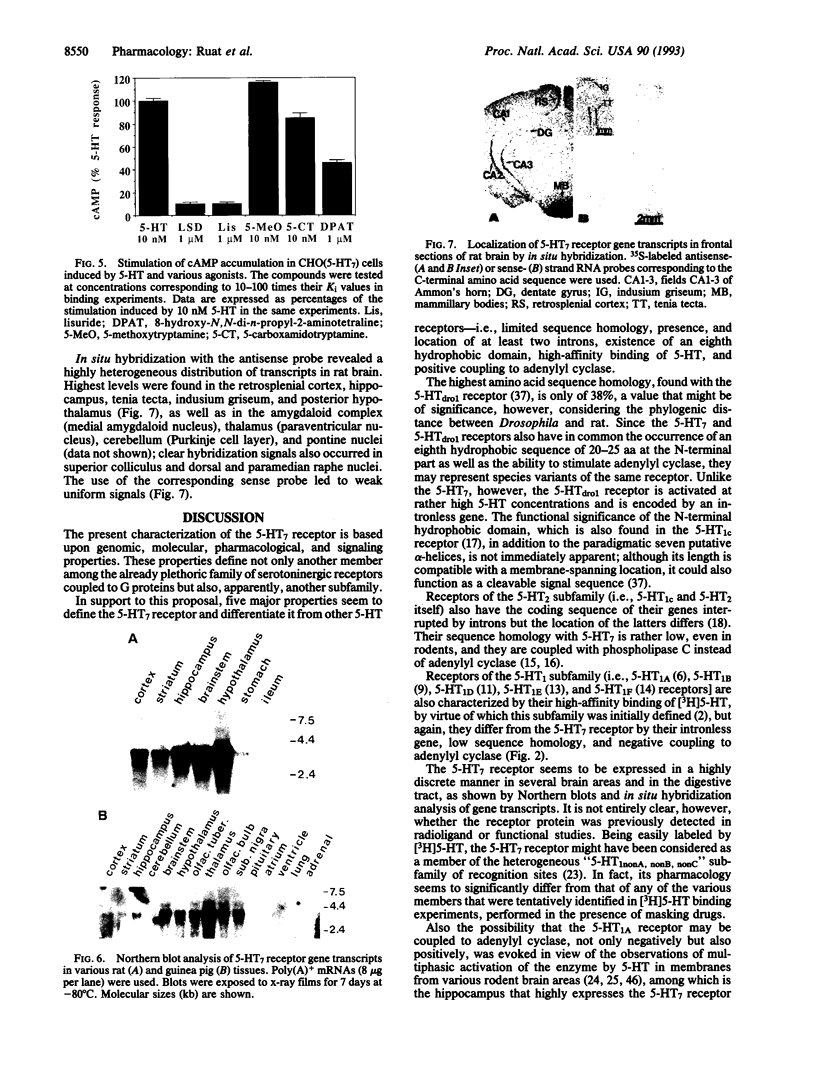
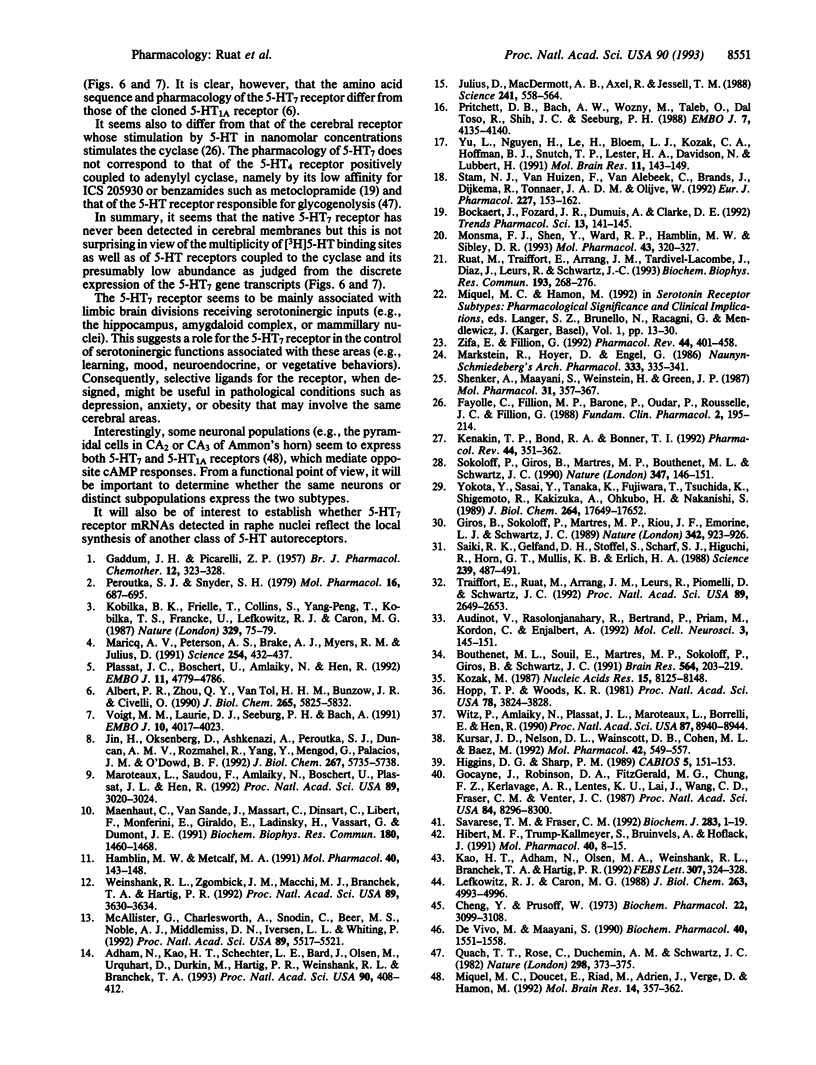
Images in this article
Selected References
These references are in PubMed. This may not be the complete list of references from this article.
- Adham N., Kao H. T., Schecter L. E., Bard J., Olsen M., Urquhart D., Durkin M., Hartig P. R., Weinshank R. L., Branchek T. A. Cloning of another human serotonin receptor (5-HT1F): a fifth 5-HT1 receptor subtype coupled to the inhibition of adenylate cyclase. Proc Natl Acad Sci U S A. 1993 Jan 15;90(2):408–412. doi: 10.1073/pnas.90.2.408. [DOI] [PMC free article] [PubMed] [Google Scholar]
- Albert P. R., Zhou Q. Y., Van Tol H. H., Bunzow J. R., Civelli O. Cloning, functional expression, and mRNA tissue distribution of the rat 5-hydroxytryptamine1A receptor gene. J Biol Chem. 1990 Apr 5;265(10):5825–5832. [PubMed] [Google Scholar]
- Bockaert J., Fozard J. R., Dumuis A., Clarke D. E. The 5-HT4 receptor: a place in the sun. Trends Pharmacol Sci. 1992 Apr;13(4):141–145. doi: 10.1016/0165-6147(92)90051-7. [DOI] [PubMed] [Google Scholar]
- Bouthenet M. L., Souil E., Martres M. P., Sokoloff P., Giros B., Schwartz J. C. Localization of dopamine D3 receptor mRNA in the rat brain using in situ hybridization histochemistry: comparison with dopamine D2 receptor mRNA. Brain Res. 1991 Nov 15;564(2):203–219. doi: 10.1016/0006-8993(91)91456-b. [DOI] [PubMed] [Google Scholar]
- Cheng Y., Prusoff W. H. Relationship between the inhibition constant (K1) and the concentration of inhibitor which causes 50 per cent inhibition (I50) of an enzymatic reaction. Biochem Pharmacol. 1973 Dec 1;22(23):3099–3108. doi: 10.1016/0006-2952(73)90196-2. [DOI] [PubMed] [Google Scholar]
- De Vivo M., Maayani S. Stimulation and inhibition of adenylyl cyclase by distinct 5-hydroxytryptamine receptors. Biochem Pharmacol. 1990 Oct 1;40(7):1551–1558. doi: 10.1016/0006-2952(90)90453-r. [DOI] [PubMed] [Google Scholar]
- Fayolle C., Fillion M. P., Barone P., Oudar P., Rousselle J. C., Fillion G. 5-Hydroxytryptamine stimulates two distinct adenylate cyclase activities in rat brain: high-affinity activation is related to a 5-HT1 subtype different from 5-HT1A, 5-HT1B, and 5-HT1C. Fundam Clin Pharmacol. 1988;2(3):195–214. doi: 10.1111/j.1472-8206.1988.tb00632.x. [DOI] [PubMed] [Google Scholar]
- GADDUM J. H., PICARELLI Z. P. Two kinds of tryptamine receptor. Br J Pharmacol Chemother. 1957 Sep;12(3):323–328. doi: 10.1111/j.1476-5381.1957.tb00142.x. [DOI] [PMC free article] [PubMed] [Google Scholar]
- Giros B., Sokoloff P., Martres M. P., Riou J. F., Emorine L. J., Schwartz J. C. Alternative splicing directs the expression of two D2 dopamine receptor isoforms. Nature. 1989 Dec 21;342(6252):923–926. doi: 10.1038/342923a0. [DOI] [PubMed] [Google Scholar]
- Gocayne J., Robinson D. A., FitzGerald M. G., Chung F. Z., Kerlavage A. R., Lentes K. U., Lai J., Wang C. D., Fraser C. M., Venter J. C. Primary structure of rat cardiac beta-adrenergic and muscarinic cholinergic receptors obtained by automated DNA sequence analysis: further evidence for a multigene family. Proc Natl Acad Sci U S A. 1987 Dec;84(23):8296–8300. doi: 10.1073/pnas.84.23.8296. [DOI] [PMC free article] [PubMed] [Google Scholar]
- Hamblin M. W., Metcalf M. A. Primary structure and functional characterization of a human 5-HT1D-type serotonin receptor. Mol Pharmacol. 1991 Aug;40(2):143–148. [PubMed] [Google Scholar]
- Hibert M. F., Trumpp-Kallmeyer S., Bruinvels A., Hoflack J. Three-dimensional models of neurotransmitter G-binding protein-coupled receptors. Mol Pharmacol. 1991 Jul;40(1):8–15. [PubMed] [Google Scholar]
- Higgins D. G., Sharp P. M. Fast and sensitive multiple sequence alignments on a microcomputer. Comput Appl Biosci. 1989 Apr;5(2):151–153. doi: 10.1093/bioinformatics/5.2.151. [DOI] [PubMed] [Google Scholar]
- Hopp T. P., Woods K. R. Prediction of protein antigenic determinants from amino acid sequences. Proc Natl Acad Sci U S A. 1981 Jun;78(6):3824–3828. doi: 10.1073/pnas.78.6.3824. [DOI] [PMC free article] [PubMed] [Google Scholar]
- Jin H., Oksenberg D., Ashkenazi A., Peroutka S. J., Duncan A. M., Rozmahel R., Yang Y., Mengod G., Palacios J. M., O'Dowd B. F. Characterization of the human 5-hydroxytryptamine1B receptor. J Biol Chem. 1992 Mar 25;267(9):5735–5738. [PubMed] [Google Scholar]
- Julius D., MacDermott A. B., Axel R., Jessell T. M. Molecular characterization of a functional cDNA encoding the serotonin 1c receptor. Science. 1988 Jul 29;241(4865):558–564. doi: 10.1126/science.3399891. [DOI] [PubMed] [Google Scholar]
- Kao H. T., Adham N., Olsen M. A., Weinshank R. L., Branchek T. A., Hartig P. R. Site-directed mutagenesis of a single residue changes the binding properties of the serotonin 5-HT2 receptor from a human to a rat pharmacology. FEBS Lett. 1992 Aug 3;307(3):324–328. doi: 10.1016/0014-5793(92)80705-l. [DOI] [PubMed] [Google Scholar]
- Kenakin T. P., Bond R. A., Bonner T. I. Definition of pharmacological receptors. Pharmacol Rev. 1992 Sep;44(3):351–362. [PubMed] [Google Scholar]
- Kobilka B. K., Frielle T., Collins S., Yang-Feng T., Kobilka T. S., Francke U., Lefkowitz R. J., Caron M. G. An intronless gene encoding a potential member of the family of receptors coupled to guanine nucleotide regulatory proteins. Nature. 1987 Sep 3;329(6134):75–79. doi: 10.1038/329075a0. [DOI] [PubMed] [Google Scholar]
- Kozak M. An analysis of 5'-noncoding sequences from 699 vertebrate messenger RNAs. Nucleic Acids Res. 1987 Oct 26;15(20):8125–8148. doi: 10.1093/nar/15.20.8125. [DOI] [PMC free article] [PubMed] [Google Scholar]
- Kursar J. D., Nelson D. L., Wainscott D. B., Cohen M. L., Baez M. Molecular cloning, functional expression, and pharmacological characterization of a novel serotonin receptor (5-hydroxytryptamine2F) from rat stomach fundus. Mol Pharmacol. 1992 Oct;42(4):549–557. [PubMed] [Google Scholar]
- Lefkowitz R. J., Caron M. G. Adrenergic receptors. Models for the study of receptors coupled to guanine nucleotide regulatory proteins. J Biol Chem. 1988 Apr 15;263(11):4993–4996. [PubMed] [Google Scholar]
- Maenhaut C., Van Sande J., Massart C., Dinsart C., Libert F., Monferini E., Giraldo E., Ladinsky H., Vassart G., Dumont J. E. The orphan receptor cDNA RDC4 encodes a 5-HT1D serotonin receptor. Biochem Biophys Res Commun. 1991 Nov 14;180(3):1460–1468. doi: 10.1016/s0006-291x(05)81360-9. [DOI] [PubMed] [Google Scholar]
- Maricq A. V., Peterson A. S., Brake A. J., Myers R. M., Julius D. Primary structure and functional expression of the 5HT3 receptor, a serotonin-gated ion channel. Science. 1991 Oct 18;254(5030):432–437. doi: 10.1126/science.1718042. [DOI] [PubMed] [Google Scholar]
- Markstein R., Hoyer D., Engel G. 5-HT1A-receptors mediate stimulation of adenylate cyclase in rat hippocampus. Naunyn Schmiedebergs Arch Pharmacol. 1986 Aug;333(4):335–341. doi: 10.1007/BF00500006. [DOI] [PubMed] [Google Scholar]
- Maroteaux L., Saudou F., Amlaiky N., Boschert U., Plassat J. L., Hen R. Mouse 5HT1B serotonin receptor: cloning, functional expression, and localization in motor control centers. Proc Natl Acad Sci U S A. 1992 Apr 1;89(7):3020–3024. doi: 10.1073/pnas.89.7.3020. [DOI] [PMC free article] [PubMed] [Google Scholar]
- McAllister G., Charlesworth A., Snodin C., Beer M. S., Noble A. J., Middlemiss D. N., Iversen L. L., Whiting P. Molecular cloning of a serotonin receptor from human brain (5HT1E): a fifth 5HT1-like subtype. Proc Natl Acad Sci U S A. 1992 Jun 15;89(12):5517–5521. doi: 10.1073/pnas.89.12.5517. [DOI] [PMC free article] [PubMed] [Google Scholar]
- Miquel M. C., Doucet E., Riad M., Adrien J., Vergé D., Hamon M. Effect of the selective lesion of serotoninergic neurons on the regional distribution of 5-HT1A receptor mRNA in the rat brain. Brain Res Mol Brain Res. 1992 Aug;14(4):357–362. doi: 10.1016/0169-328x(92)90104-j. [DOI] [PubMed] [Google Scholar]
- Monsma F. J., Jr, Shen Y., Ward R. P., Hamblin M. W., Sibley D. R. Cloning and expression of a novel serotonin receptor with high affinity for tricyclic psychotropic drugs. Mol Pharmacol. 1993 Mar;43(3):320–327. [PubMed] [Google Scholar]
- Peroutka S. J., Snyder S. H. Multiple serotonin receptors: differential binding of [3H]5-hydroxytryptamine, [3H]lysergic acid diethylamide and [3H]spiroperidol. Mol Pharmacol. 1979 Nov;16(3):687–699. [PubMed] [Google Scholar]
- Plassat J. L., Boschert U., Amlaiky N., Hen R. The mouse 5HT5 receptor reveals a remarkable heterogeneity within the 5HT1D receptor family. EMBO J. 1992 Dec;11(13):4779–4786. doi: 10.1002/j.1460-2075.1992.tb05583.x. [DOI] [PMC free article] [PubMed] [Google Scholar]
- Pritchett D. B., Bach A. W., Wozny M., Taleb O., Dal Toso R., Shih J. C., Seeburg P. H. Structure and functional expression of cloned rat serotonin 5HT-2 receptor. EMBO J. 1988 Dec 20;7(13):4135–4140. doi: 10.1002/j.1460-2075.1988.tb03308.x. [DOI] [PMC free article] [PubMed] [Google Scholar]
- Quach T. T., Rose C., Duchemin A. M., Schwartz J. C. Glycogenolysis induced by serotonin in brain: identification of a new class of receptor. Nature. 1982 Jul 22;298(5872):373–375. doi: 10.1038/298373a0. [DOI] [PubMed] [Google Scholar]
- Ruat M., Traiffort E., Arrang J. M., Tardivel-Lacombe J., Diaz J., Leurs R., Schwartz J. C. A novel rat serotonin (5-HT6) receptor: molecular cloning, localization and stimulation of cAMP accumulation. Biochem Biophys Res Commun. 1993 May 28;193(1):268–276. doi: 10.1006/bbrc.1993.1619. [DOI] [PubMed] [Google Scholar]
- Saiki R. K., Gelfand D. H., Stoffel S., Scharf S. J., Higuchi R., Horn G. T., Mullis K. B., Erlich H. A. Primer-directed enzymatic amplification of DNA with a thermostable DNA polymerase. Science. 1988 Jan 29;239(4839):487–491. doi: 10.1126/science.2448875. [DOI] [PubMed] [Google Scholar]
- Savarese T. M., Fraser C. M. In vitro mutagenesis and the search for structure-function relationships among G protein-coupled receptors. Biochem J. 1992 Apr 1;283(Pt 1):1–19. doi: 10.1042/bj2830001. [DOI] [PMC free article] [PubMed] [Google Scholar]
- Shenker A., Maayani S., Weinstein H., Green J. P. Pharmacological characterization of two 5-hydroxytryptamine receptors coupled to adenylate cyclase in guinea pig hippocampal membranes. Mol Pharmacol. 1987 Apr;31(4):357–367. [PubMed] [Google Scholar]
- Sokoloff P., Giros B., Martres M. P., Bouthenet M. L., Schwartz J. C. Molecular cloning and characterization of a novel dopamine receptor (D3) as a target for neuroleptics. Nature. 1990 Sep 13;347(6289):146–151. doi: 10.1038/347146a0. [DOI] [PubMed] [Google Scholar]
- Stam N. J., Van Huizen F., Van Alebeek C., Brands J., Dijkema R., Tonnaer J. A., Olijve W. Genomic organization, coding sequence and functional expression of human 5-HT2 and 5-HT1A receptor genes. Eur J Pharmacol. 1992 Oct 1;227(2):153–162. doi: 10.1016/0922-4106(92)90123-d. [DOI] [PubMed] [Google Scholar]
- Traiffort E., Ruat M., Arrang J. M., Leurs R., Piomelli D., Schwartz J. C. Expression of a cloned rat histamine H2 receptor mediating inhibition of arachidonate release and activation of cAMP accumulation. Proc Natl Acad Sci U S A. 1992 Apr 1;89(7):2649–2653. doi: 10.1073/pnas.89.7.2649. [DOI] [PMC free article] [PubMed] [Google Scholar]
- Voigt M. M., Laurie D. J., Seeburg P. H., Bach A. Molecular cloning and characterization of a rat brain cDNA encoding a 5-hydroxytryptamine1B receptor. EMBO J. 1991 Dec;10(13):4017–4023. doi: 10.1002/j.1460-2075.1991.tb04977.x. [DOI] [PMC free article] [PubMed] [Google Scholar]
- Weinshank R. L., Zgombick J. M., Macchi M. J., Branchek T. A., Hartig P. R. Human serotonin 1D receptor is encoded by a subfamily of two distinct genes: 5-HT1D alpha and 5-HT1D beta. Proc Natl Acad Sci U S A. 1992 Apr 15;89(8):3630–3634. doi: 10.1073/pnas.89.8.3630. [DOI] [PMC free article] [PubMed] [Google Scholar]
- Witz P., Amlaiky N., Plassat J. L., Maroteaux L., Borrelli E., Hen R. Cloning and characterization of a Drosophila serotonin receptor that activates adenylate cyclase. Proc Natl Acad Sci U S A. 1990 Nov;87(22):8940–8944. doi: 10.1073/pnas.87.22.8940. [DOI] [PMC free article] [PubMed] [Google Scholar]
- Yokota Y., Sasai Y., Tanaka K., Fujiwara T., Tsuchida K., Shigemoto R., Kakizuka A., Ohkubo H., Nakanishi S. Molecular characterization of a functional cDNA for rat substance P receptor. J Biol Chem. 1989 Oct 25;264(30):17649–17652. [PubMed] [Google Scholar]
- Yu L., Nguyen H., Le H., Bloem L. J., Kozak C. A., Hoffman B. J., Snutch T. P., Lester H. A., Davidson N., Lübbert H. The mouse 5-HT1C receptor contains eight hydrophobic domains and is X-linked. Brain Res Mol Brain Res. 1991 Sep;11(2):143–149. doi: 10.1016/0169-328x(91)90116-f. [DOI] [PubMed] [Google Scholar]
- Zifa E., Fillion G. 5-Hydroxytryptamine receptors. Pharmacol Rev. 1992 Sep;44(3):401–458. [PubMed] [Google Scholar]




